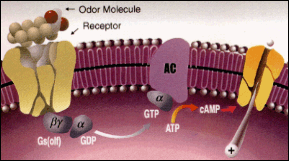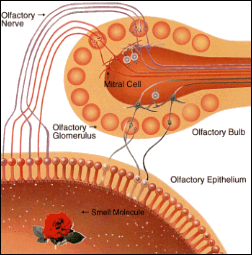In order to find out about the true character of the smells which cause in us such a large variety of emotions we questioned Dr. Kensaku Mori the Head of the Laboratory for Neuronal Recognition Molecules who is leading the research into olfaction.
|
Q : How is it that you have selected the olfactory system as your research subject ?
A : I started research into the olfactory system about twenty-five years ago. At that time, olfaction was much neglected compared to the fields of vision and audition, and basically almost nothing was known in this field. I started researching into it thinking that such an unknown world would be a promising research area offering perhaps interesting question and discoveries. But it was to be later, in 1991 when the receptor proteins of odor molecules were discovered by Buck and Axel that the research became really active.
| - |

|
Fig.1 Mechanism of Smell Molecule Reception
a:a Subunit of Golf Br: Br Subunit of Golf
Ac: Adenylate cyclase ATP: Adenosine triphosphate
cAMP: Cyclic Adenosine monophosphate
GDP: guanosine diphosphate
GTP: Guanosine triphosphate
Gs(olf): Olfactry cell-specific GTP-binding protein
|
Q : You spoke about "smell molecules" ?
A : Yes, the source of smell is actually a large number of invisibly small odor molecules which are emitted from matter. These molecules enter the nose, stimulate the brain and cause emotions in it. The judgment of comfort and discomfort is closely allied to the input of smell . The olfactory system directly affects the brain systems which control emotion (such as the amygdaloid complex and the hypothalamus). This is a characteristic of the olfactory system that cannot be found in the visual or auditory systems. Thus I believe that research into olfaction holds the key to the understanding of the mechanisms of the comfort /discomfort emotions, which have not been clear up until the present due to an absence of scientific elucidation methods.
Q : How has the discovery of the receptor proteins enabled this breakthrough?
A : With the olfactory sense, a large number of different receptors exist to deal with 400,000 to 500,000 kinds of odor molecules. This discovery showed that there are almost 1,000 types of such receptors which was really amazing to us, because previous research had been considering that about 20 types of receptors are used to identify smell molecules. Then how, we asked, can the brain process signals from such a wide variety of different receptors and identify information such as good and bad of smells? Improved knowledge of the large variety of receptors started to pose important questions.
Q : But what are the receptors ?
A : The receptors are proteins located in the olfactory sensory cells arranged on the ceiling sections of the nostrils and have a kind of pocket structure. Each of the thousand or so types of receptors has a different pocket structure shape from other receptors in order to receive the odor molecules that fit its shape. But a thousand receptor types are not nearly enough to receive 400,000 kinds of odor molecules. It began to become evident that there is a "loose relationship" between the receptors and odor molecules. In other words, a pocket structure does not receive the odor molecules that fit it perfectly but also those with similar characteristics.
Q : How is the information transmitted from the receptors to the brain ?
A : In this area too, it began to became clear that there is a very well-arranged connection between receptors and molecules.
The nose has at least several thousands receptors of each type, and all of the pathways from receptors of a specific type are connected to the same two input terminal in the olfactory bulb (olfactory glomeruli). This means that the information on the in-nose sensors (receptors) presently bonded with odor molecules can be identified by checking the input signals in these terminals in the olfactory bulb. The brain is thus able to identify and classify odor molecules based on such processes. Also, there should be a process of the higher brain function of feeling a specific emotion by sensing a specific smell. We hope to develop our future research toward the elucidation of such a concept.
Q : We've heard that your laboratory recently discovered a new fact concerning the mechanisms of the olfactory bulb.
A : Yes, the mechanism of the qualitative classification of smells, or how the information of a specific group of odor receptors is transmitted to the specific zone in the olfactory bulb, has started to become clear.
The olfactory bulb of the mammal is divided into four zones and, for example, a part of zone I recognizes "pungent odors" like the odor of fat. And the formation of each zone is controlled by a membrane protein called the OCAM (Olfactory Cell Adhesion Molecule). The OCAM might be involved in the formation of synapse between the axons of olfactory cells (i.e. the molecular pathways to the input terminal) and the mitral cells of the olfactory bulb (i.e. the pathways to enter the brain).
Q : There are people who are particularly good at distinguishing smells, for example perfume blenders.
A : Let me simplify the story and assume that there are two sensors, sensor A and sensor B excited by the odors of banana. These two sensors transmit signals simultaneously to the input terminals assigned to them, and there is a neuronal ciucuit which identifies that the signals are "simultaneously occurring" in the input terminals. This circuit can be reinforced and developed through training. It is these circuits that integrate the information from tens of sensors into a single smell. If a perfume blender is said to have a good nose, this does not mean that he has special sensors or more sensors than others, but that his neural connection memorizing which combinations of sensors form a specific smell is more developed than in ordinary people.
Q : What is the actual status of your research, and how do you conduct it ?
A : The research into olfaction has now stepped into the more complicated, higher central part of the brain. Nevertheless, although not much time has elapsed since the discovery of the receptors, at the level of the basic structures and functions of the olfactory mechanisms much has started to become clear.
Our laboratory is conducting research by dividing it into three stages, at the level of olfactory sensory cells in the nose, at the level of the olfactory bulb which is said to be the first relay center, and at the level of the olfactoty cortex which is regarded as an unknown area. Therefore, we basically use any available means in research. For example, our research into the olfactory system utilizes many basic research methods including those of molecular biology, electro-physiology and optical measurement. Since brain research is a field where it is extremely difficult for a single group to elucidate everything, cooperation with other laboratories is essential for us.
| - |

Fig.2 Olfactory Neural Pathway |
Q : What are the results of olfactory research that can benefit human society in general?
A : I firmly believe that any result of basic research can make a contribution to society, but honestly speaking I do not know what shape the contribution of these results of ours will take.
For instance, our laboratory has discovered a molecule with a new function from the olfactory bulb which we have called telencephalin. This molecule is unique in that it manifests only in the neurons of the telencephalon, which is the most developed, critical segment of the human brain.
It was reported in the medical magazine "The Lancet" earlier this year that the telencephalin concentration in blood serum increases when the brain is damaged by epilepsy or herpes encephalitis. In the past it has not been able to identify brain damage unless the deep brain wave was examined, but it has now become possible to diagnose damage by measuring the telencephalin concentration.
It is in such an unexpected way that basic research achieves socially significant results. So, even if we can imagine events five years into the future, we can never know what will actually take place until that time.
Q : Finally, please tell us about your desires and intentions for olfactory research in the future.
A : After all, I believe that what is truly important is the establishment and accumulation of basic knowledge. Research into a topic of basic knowledge is absolutely necessary for obtaining subsequent advances in knowledge. From basic knowledge which has been fortuitously obtained, another researcher advances his or her studies and increases knowledge. This is the merit of basic research. I think that basic olfactory research is linked with research in other fields and eventually an academic platform is created with them for the general elucidation of the mechanisms of the brain.






